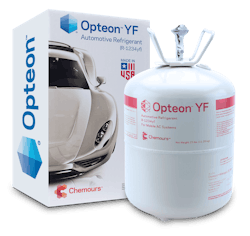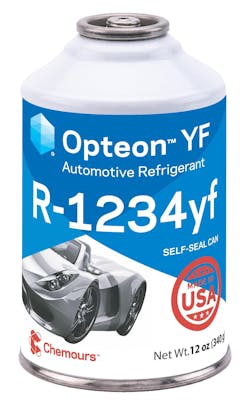Developing a strong refrigerant management plan
The change the automotive market has been hearing about for years has arrived in the U.S. The groundwork was laid in 2011 when the European Union began phasing out the use of the hydrofluorocarbons (HFCs), including R-134a, and mandated that by 2017, all new light-duty vehicles entering the market be charged with a lower global warming potential (GWP) refrigerant. With the U.S. EPA pursuing similar regulations, R-1234yf — a hydrofluoroolefin (HFO) delivering zero ozone depletion potential (ODP) plus a low (< 1 AR5 value) GWP — has commanded attention. In addition, General Motors achieved full conversion to R-1234yf systems by 2018 and paved the way for other manufacturers in the U.S., Asia, and Canada to follow. Lastly, R-1234yf is an effective and efficient solution for replacing R-134a in electric vehicle applications. This creates an even larger number of vehicles charged with the refrigerant.
Members of the automotive aftermarket may be concerned that as soon as they prepare for the transition to R-1234yf and open their business to servicing cars charged with it, something else will come along that will require them to make another costly change. The Chemours Company, the inventers of Freon™ and the largest manufacturers of R-1234YF, worked to ensure the chemistry behind the two biggest refrigerants in play for the aftermarket today was developed to stand the test of time. It will likely be quite some time before a new mobile air-conditioning refrigerant is necessary. This is because R-1234yf delivers what’s needed in terms of environmental responsibility, regulatory longevity, safety, performance, and the flexibility to work in systems ranging from gas-powered internal-combustion vehicles to hybrids and EVs. Therefore, it is imperative for automotive aftermarket businesses to have a strong refrigerant management plan that allows them to service R-134a vehicles and the growing number of R-1234yf vehicles that many shops are already experiencing.
A few numbers support R-1234yf service capabilities as a smart business plan:
- More than 95 percent — the estimated percentage of vehicles manufactured for sale in the U.S. that use R-1234yf
- 95 million — the number of vehicles currently on the road in the U.S. charged with R-1234yf
- 15 million — the number of vehicles that come out of warranty annually
- 30 percent fleet size — Given the above, by year-end 2023, the industry can assume more than 30 percent of the fleet will be comprised of vehicles using R-1234yf
The Impact of U.S. regulations
Under the American Innovation and Manufacturing (AIM) Act, the industry has already experienced a significant initial reduction in the phasedown of HFC refrigerants. Starting Jan. 1, 2024, the next step will require an additional 30 percent reduction in HFC production and consumption. In addition, the EPA’s Significant New Alternatives Policy (SNAP) listings for new R-1234yf applications are driving expanded use. HFO-1234yf is currently listed as “acceptable with conditions” for mobile air conditioning systems in newly manufactured passenger cars, light-duty trucks, medium-duty passenger vehicles, heavy-duty pickup trucks, complete heavy-duty vans, and heavy-duty nonroad vehicles.
Developing your refrigerant management plan
To ensure your shop is ready to capture current and expanding R-1234yf business, start by embracing the familiarity and advantages of this new-generation refrigerant. On the familiarity side, R-1234yf offers a close match — in terms of energy efficiency, capacity, and thermodynamic properties — to the R-134a shops have been working with for years. On the advantages side, R-1234yf has a lower GWP compared to R-134a, supports sustainability goals, and offers energy efficiency and longevity in the changing regulatory landscape.
Next, understand the differences that dictate the need for additional equipment and training. The major distinction is that R-1234yf is a mildly flammable A2L. Users should know and follow all safe service practices to mitigate any risks. Attempting to mix R-1234yf and R-134a or use one in a system manufactured for the other will lead to cross-contamination that could potentially damage the AC system. R/R/R machines for R-1234yf cylinders and hose-gauge manifold equipment for R-1234yf cans use left-hand threads to prevent use with the right-hand-threaded R-134a equipment. Lastly, remember that if your shop uses R-134a in a car manufactured for R-1234yf, you could incur steep penalties, because it is illegal to do so under the U.S. EPA Clean Air Act.
Once you have this knowledge, assess your shop’s specific needs to determine the equipment and amount of R-1234yf you should have on hand to support the business that will be coming in.
As soon as possible, ensure the equipment and the people in your shop are set to service R-1234yf vehicles. All technicians should be trained specifically in the proper and safe handling and use of the R-1234yf, because it is an A2L mildly flammable refrigerant. In addition, if you are using cylinders, you are required to obtain EPA section 609 certification. Lastly, pay heed to supply chains and availability of the equipment you need. If you feel you’ll be ready to use cylinders in the near future, it’s good practice to put your orders in now.
A final guideline is to be fluid in your planning. The need to service R-1234yf is going to grow exponentially, and the flow of R-134a vehicles coming into your shop will subside. However, both will be coming in for the foreseeable future. Do regular assessments of your business so you can keep track of the trends and adjust your refrigerant supply accordingly.
About the Author

Christina Spalding
Americas Marketing Manager—Automotive OEM and Aftermarket Refrigerants, The Chemours Company
Every day, Christina draws on more than 25 years of experience in the refrigerants industry to provide a diverse range of customers solutions rooted in tried-and-true chemistry formulated for today’s most demanding performance and environmental needs. Through her career journey, Christina has gained expertise in both stationary and mobile refrigeration applications, and she has supported the industry through every major transformation, starting with the transition from ozone-depleting refrigerants (HCFCs) to non-ozone-depleting refrigerants (HFCs), then from HFCs to lower global warming potential (GWP) HFOs. Today, she is a champion of ultra-low global warming refrigerants for the automotive industry and leads Chemours’s marketing efforts in North and South America for automotive OEMs and the automotive aftermarket.


